Modification of Serine 1040 of SIBRI1 Increases Fruit Yield by Enhancing Tolerance to Heat Stress in Tomato
- PMID: 33081382
- PMCID: PMC7589314
- DOI: 10.3390/ijms21207681
Modification of Serine 1040 of SIBRI1 Increases Fruit Yield by Enhancing Tolerance to Heat Stress in Tomato
Abstract
High temperature is a major environmental factor that adversely affects plant growth and production. SlBRI1 is a critical receptor in brassinosteroid signalling, and its phosphorylation sites have differential functions in plant growth and development. However, the roles of the phosphorylation sites of SIBRI1 in stress tolerance are unknown. In this study, we investigated the biological functions of the phosphorylation site serine 1040 (Ser-1040) of SlBRI1 in tomato. Phenotype analysis indicated that transgenic tomato harbouring SlBRI1 dephosphorylated at Ser-1040 showed increased tolerance to heat stress, exhibiting better plant growth and plant yield under high temperature than transgenic lines expressing SlBRI1 or SlBRI1 phosphorylated at Ser-1040. Biochemical and physiological analyses further showed that antioxidant activity, cell membrane integrity, osmo-protectant accumulation, photosynthesis and transcript levels of heat stress defence genes were all elevated in tomato plants harbouring SlBRI1 dephosphorylated at Ser-1040, and the autophosphorylation level of SlBRI1 was inhibited when SlBRI1 dephosphorylated at Ser-1040. Taken together, our results demonstrate that the phosphorylation site Ser-1040 of SlBRI1 affects heat tolerance, leading to improved plant growth and yield under high-temperature conditions. Our results also indicate the promise of phosphorylation site modification as an approach for protecting crop yields from high-temperature stress.
Keywords: SlBRI1; heating tolerance; phosphorylation site; tomato; yield.
Conflict of interest statement
The authors declare no conflict of interest.
Figures

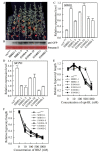
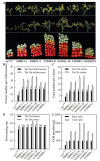
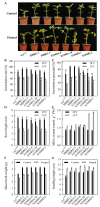

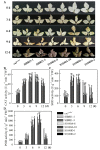
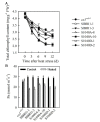

Similar articles
-
Modification of Threonine-825 of SlBRI1 Enlarges Cell Size to Enhance Fruit Yield by Regulating the Cooperation of BR-GA Signaling in Tomato.Int J Mol Sci. 2021 Jul 18;22(14):7673. doi: 10.3390/ijms22147673. Int J Mol Sci. 2021. PMID: 34299293 Free PMC article.
-
Modification of Threonine-1050 of SlBRI1 regulates BR Signalling and increases fruit yield of tomato.BMC Plant Biol. 2019 Jun 13;19(1):256. doi: 10.1186/s12870-019-1869-9. BMC Plant Biol. 2019. PMID: 31196007 Free PMC article.
-
Enhanced brassinosteroid signaling via the overexpression of SlBRI1 positively regulates the chilling stress tolerance of tomato.Plant Sci. 2022 Jul;320:111281. doi: 10.1016/j.plantsci.2022.111281. Epub 2022 Apr 4. Plant Sci. 2022. PMID: 35643607
-
The role of auxin and gibberellin in tomato fruit set.J Exp Bot. 2009;60(5):1523-32. doi: 10.1093/jxb/erp094. Epub 2009 Mar 25. J Exp Bot. 2009. PMID: 19321650 Review.
-
An overview of heat stress in tomato (Solanum lycopersicum L.).Saudi J Biol Sci. 2021 Mar;28(3):1654-1663. doi: 10.1016/j.sjbs.2020.11.088. Epub 2020 Dec 8. Saudi J Biol Sci. 2021. PMID: 33732051 Free PMC article. Review.
Cited by
-
Modification of Threonine-825 of SlBRI1 Enlarges Cell Size to Enhance Fruit Yield by Regulating the Cooperation of BR-GA Signaling in Tomato.Int J Mol Sci. 2021 Jul 18;22(14):7673. doi: 10.3390/ijms22147673. Int J Mol Sci. 2021. PMID: 34299293 Free PMC article.
-
Cell Signaling in Model Plants 2.0.Int J Mol Sci. 2021 Jul 27;22(15):8007. doi: 10.3390/ijms22158007. Int J Mol Sci. 2021. PMID: 34360772 Free PMC article.
-
Evolutionary analysis and functional characterization of SiBRI1 as a Brassinosteroid receptor gene in foxtail millet.BMC Plant Biol. 2021 Jun 24;21(1):291. doi: 10.1186/s12870-021-03081-8. BMC Plant Biol. 2021. PMID: 34167462 Free PMC article.
-
Heat stress impairs floral meristem termination and fruit development by affecting the BR-SlCRCa cascade in tomato.Plant Commun. 2024 Apr 8;5(4):100790. doi: 10.1016/j.xplc.2023.100790. Epub 2024 Jan 1. Plant Commun. 2024. PMID: 38168638 Free PMC article.
References
-
- Suzuki N., Mittler R. Reactive oxygen species and temperature stresses: A delicate balance between signaling and destruction. Physiol. Plant. 2006;126:45–51. doi: 10.1111/j.0031-9317.2005.00582.x. - DOI
-
- Fariduddin Q., Yusuf M., Ahmad I., Ahmad A. Brassinosteroids and their role in response of plants to abiotic stresses. Biol. Plantarum. 2014;58:9–17. doi: 10.1007/s10535-013-0374-5. - DOI
MeSH terms
Substances
Grants and funding
LinkOut - more resources
Full Text Sources

